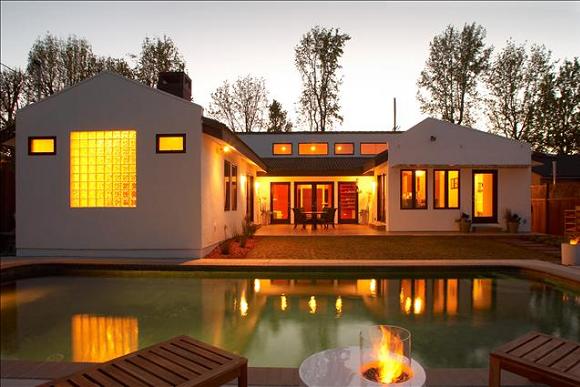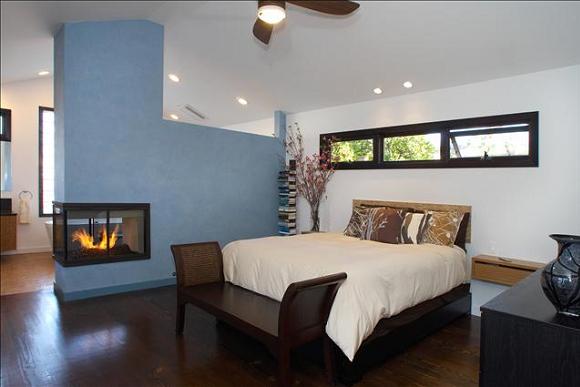Original URL: https://www.theregister.com/2010/04/28/zero_energy_house_not_so_much/
California's 'Zero Energy House' is actually massive fossil hog
'Zenergy' eco-home gets award from local senator anyway
Posted in Science, 28th April 2010 13:50 GMT
In startling enviro-technology news, it has been reported that an ordinary 1950s house in California has been given a "green renovation" which has apparently made it a "Zero Energy House" and won its builders an award from the state government.

Not some nasty cold, dark hut for unwashed primitives, oh no
This is pretty interesting stuff, as the US Department of Energy says (pdf) that a "Zero Energy" building is one "with greatly reduced energy needs through efficiency gains such that the balance of energy needs can be supplied with renewable technologies".
In other words the Californian prototype house can supply all the energy it needs over time through its own renewable microgeneration equipment - if it uses external electricity supplies such as grid power at times, it compensates for this by providing surplus juice of its own back to the grid at others.
This sort of thing has always been possible, of course, but it generally means a dwelling without heating, hot water, cooking or air conditioning (the latter often seen as essential to life in much of California) and not a lot in the way of electrical appliances either.
But the Zero Energy ("Zenergy") House Prototype, created by Residential Energy Assessment Services ("Making Los Angeles Green") is no such primitive icebox/hothouse, suitable only for unwashed people in smelly clothes who eat their food raw and go to bed when it gets dark. It has heating, air conditioning, hot water, cooking, plenty of lights and appliances. Yet it is still "Zero Energy".
Eco-design news hub Inhabitat ("Green design will save the world"!) reported on the Zenergy House Protoype's opening this week in gushing terms:
The Zenergy House is a 1950’s [sic] remodel that delivers high on sustainability and low on energy use — net zero to be exact — thanks to the use of super-efficient green building strategies and solar panels on the roof ... The home is tricked out from head to toe with sustainable features and products, including a lot of the furnishings and accessories.
REAS themselves describe the remodelling process under the heading "Goal - Net Zero Energy".
But how did the technical wizards of REAS manage to deliver net zero energy with heating, aircon and all the trimmings in a 1950s house with nothing more than a few solar panels to power it?
We couldn't imagine how, so we asked them and company vice-president Ron Schwolsky promptly and courteously answered our questions. Unfortunately, the short answer as to how on Earth they made a house comfortable while using no energy from outside is that they didn't.
'Zero Net Energy' = One-third more fossil power than the average household
The "Zero Energy" prototype, in the course of its green makeover, had its oldschool US style twin furnaces replaced with a "combined hydronic heating system" using gas to provide heat and hot water. "Hydronic" simply means the use of water to transmit heat generated in some other way - in this case by burning fossil fuel, specifically natural gas.

That'll be one of those zero-energy gas fires
According to Schwolsky:
We averaged 85 Therms a month from December '09 through march 2010 (our heating season in LA). We are not including the use of natural gas or water into our "Zero Energy" calculations.The "Zero Energy" refers to electrical use only.
Onward[!]
Eighty-five therms is the same as 2491 kilowatt-hours per month. A normal household in the Western USA, according to the US government, uses 77 million British Thermal Units annually - which is the same as 1881 kilowatt-hours per month. The Zenergy house uses a third more energy than the regional household average, and one may note that by American standards it is by no means large (3 bedrooms, 3 bathrooms).
Not only is the house not zero-net-energy, it actually seems to be something of a power hog as American houses go.
REAS are being more than a bit cheeky with their use of words here, but they don't make any serious effort to obscure the real nature of the "Zenergy" project - which is no more than massively overhyped marketing for new heating installations, AC units, loft insulation and so on.
It is more than a little startling, though, that the energy-hog house was given an "Environmental Sustainability Award" by the California state senate - apparently presented in person by Senator Fran Pavley, who represents the 23rd district (parts of Los Angeles and Ventura counties) in Sacramento.
And how could the "green design" advertorial newshawks of Inhabitat get it so wrong, too?
A brief glance at the qualifications of the reporter (sorry "senior contributing editor") who wrote the piece may provide a clue to those familiar with the mad eco notions often espoused by the architecture community. The fact that the site's editor-in-chief and founder Jill Fehrenbacher holds a first degree in "Art Semiotics" and another in "Design Studies" from our own Central St Martins art college here in London doesn't engender confidence in its corporate tech-savvy, either.
American readers concerned to make the greenest eco choices in buildings and houses may also care to note that both REAS' Schwolsky and Fehrenbacher hold LEED AP qualifications from the Green Building Certification Institute, endorsed by the US Green Building Council. ®